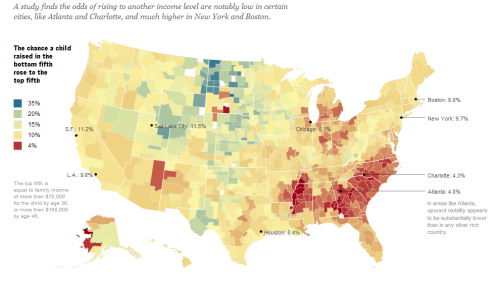Scholars Raj Chetty, Nathaniel Hedren, Patrick Kline and Emmanuel Saez (from Harvard and Berkeley) have garnered richly deserved attention for their interesting retrospective look at which places were the best in America for low-income kids to be born in 1980 and 1981 to assure the highest rates of youth mobility. [Amazingly, to do this, they were able to examine tax returns of all Americans and connect the youth with where they had grown up.]
[To explore the above map where blue areas are areas of highest mobility and red areas are areas of lowest mobility, visit the New York Times site.]
Their work rhymes with two pieces of research that we have done.
First, they find that the places that promoted the greatest level of mobility were places high in social capital. [For an image of social capital by state in the US c. 2000 see here.] This is less surprising, since other scholars have found that places with high social capital were among the places historically to invest in public high schools (e.g., Larry Katz and Claudia Goldin’s work on the birth of American public high school movement in the American heartland). Moreover, recent research by our research team, highlighted in Robert Putnam’s “Crumbling American Dreams” shows the changes in levels of community solidarity and togetherness, exemplified by the changes in his home town of Port Clinton, OH.
Second, they find that places with greater percentages of minorities were also places that afforded less social mobility for young people. This resonates with work of Ed Glaeser and Alberto Alesina on how it is harder to foster public investments in places of greater diversity (in the US and Europe) and work that we did in “E Pluribus Unum” that also discusses the short-term challenges of increased diversity.
While their work is retrospective, we are actively involved in gathering data on social mobility for youth from the bottom third of American households (in income and education) that strongly suggests that whether levels of mobility that existed for lower-third youth in the past, future rates of mobility are likely to much lower. Stay tuned for our evidence of this coming crisis and what we might do about it.






















